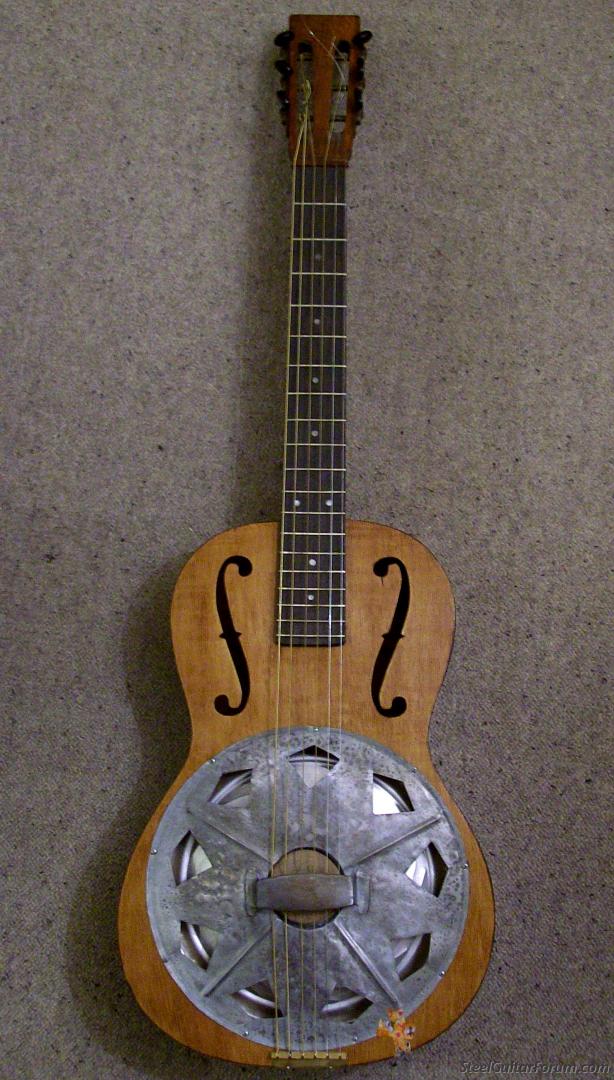Page 1 of 1
Unknown Resonator Guitar 30s. National/Harmony?
Posted: 21 Dec 2012 4:36 pm
by Manfred Nabinger
Recently I bought this resonator guitar on German ebay. Seems to be made in the US, but modified here in Germany (tuners, finish, tailpiece). It has a National style resonator cone, but a tapered biuscuit stamped "W 177". The coverplate looks a little bit like a National Rosita's coverplate. The handrest is stamped "N" on its underside.
The headstock has 3 stars stamped in and the letters "USA" on its back accompagnied by two (hardly visible) symbols looking like trees or plants. It is set up for lap steel playing (strings cannot be lowered enough for fretting when the original W -177"biscuit" is used. 24" scale, 3-layer plywood top.
I have no idea where this guitar was made. Maybe a Harmony/National cooperation from the late 30s?
Do you have any idea?

Posted: 21 Dec 2012 10:35 pm
by David Knutson
Manfred,
I saw and played a guitar just like this when I was touring in the U.K. a few years ago. I recall that the finish was darker, but the cover plate and F-holes were just the same. The shop selling it knew nothing about its origins. It looked to me like a home modified instrument, but now here I am looking at another one. ? ? ?
Posted: 22 Dec 2012 12:57 pm
by Manfred Nabinger
Hi David,
thanks for your reply. The guitar was probabely bought in the UK some yeras ago.
Most details make me think that the instrument was made in the US. But the neck is beech, hardly seen on US-guitars. And the back and sides are finished in a technique called "comb paint" which imitates exotic wood grain and can be seen on European furniture from the 20s and earlier.
Strange. Another theory: I heard that in the late 30s German manufacturers produced (or announced) resonator instruments. Never seen pictures (like for example the Weissenborn or Gibson copies by Otwin).
Posted: 22 Dec 2012 1:11 pm
by Ian McLatchie
. . .the back and sides are finished in a technique called "comb paint" which imitates exotic wood grain and can be seen on European furniture from the 20s and earlier.
Manfred: this technique was also used on American-made instruments. I have a great Kay-made solid neck Hawaiian guitar, probably from the '20s or '30s, called a Hager Artist. Hager was a department store brand, I believe. I've seen one or two of their electric steels, but never another acoustic. The top and body both appear to be solid maple, but the top is brushed to resemble spruce and the back and sides are sprayed to look like flame maple. It's a really appealing look, in a low-rent kind of way.
Posted: 23 Dec 2012 12:58 pm
by Manfred Nabinger
Here is a picture (back of the guitar) of what is called the "comb paint" (in fact more a kind of decoration than an imitation of wood structure):

Posted: 23 Dec 2012 9:32 pm
by David Knutson
I love it when fake finishes actually look fake. It's so honest. If I'm seeing right, the wood grain underneath doesn't look so bad either.
How does that one sound? The one I played in Manchester was loud but with very little sustain. Really "chunky" and bluesy.
Posted: 24 Dec 2012 1:34 pm
by Manfred Nabinger
I have put medium gauge strings on it (open D) because I don't know how much the beech wood neck can stand. Even with these strings the guitar is relatively loud. It has a broad dynamic range. The sound: between a spider and a biscuit type instrument. High strings very clear. The lowest string seems to be a little weak, would probabely sound much better in dobro tuning.
The cone is epoxy-glued to the supporting wooden ring and the biscuit is epoxy-glued to the cone. So I don't have much chance to change the setting without destroying the cone (which looks a little bit like the Delta cones made in the UK).


